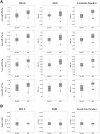A Pilot Study Identifying a Set of microRNAs As Precise Diagnostic Biomarkers of Acute Kidney Injury
- PMID: 26079930
- PMCID: PMC4469584
- DOI: 10.1371/journal.pone.0127175
A Pilot Study Identifying a Set of microRNAs As Precise Diagnostic Biomarkers of Acute Kidney Injury
Abstract
In the last decade, Acute Kidney Injury (AKI) diagnosis and therapy have not notably improved probably due to delay in the diagnosis, among other issues. Precocity and accuracy should be critical parameters in novel AKI biomarker discovery. microRNAs are key regulators of cell responses to many stimuli and they can be secreted to the extracellular environment. Therefore, they can be detected in body fluids and are emerging as novel disease biomarkers. We aimed to identify and validate serum miRNAs useful for AKI diagnosis and management. Using qRT-PCR arrays in serum samples, we determined miRNAs differentially expressed between AKI patients and healthy controls. Statistical and target prediction analysis allowed us to identify a panel of 10 serum miRNAs. This set was further validated, by qRT-PCR, in two independent cohorts of patients with relevant morbi-mortality related to AKI: Intensive Care Units (ICU) and Cardiac Surgery (CS). Statistical correlations with patient clinical parameter were performed. Our results demonstrated that the 10 selected miRNAs (miR-101-3p, miR-127-3p, miR-210-3p, miR-126-3p, miR-26b-5p, miR-29a-3p, miR-146a-5p, miR-27a-3p, miR-93-3p and miR-10a-5p) were diagnostic biomarkers of AKI in ICU patients, exhibiting areas under the curve close to 1 in ROC analysis. Outstandingly, serum miRNAs estimated before CS predicted AKI development later on, thus becoming biomarkers to predict AKI predisposition. Moreover, after surgery, the expression of the miRNAs was modulated days before serum creatinine increased, demonstrating early diagnostic value. In summary, we have identified a set of serum miRNAs as AKI biomarkers useful in clinical practice, since they demonstrate early detection and high diagnostic value and they recognize patients at risk.
Conflict of interest statement
Figures





References
-
- Srisawat N, Kellum JA. Acute kidney injury: definition, epidemiology, and outcome. Curr Opin Crit Care 201; 17(6):548–55. - PubMed
-
- Chertow GM, Burdick E, Honour M, Bonventre JV, Bates DW. Acute kidney injury, mortality, length of stay, and costs in hospitalized patients. J Am Soc Nephrol 2005; 16(11):3365–70. - PubMed
Publication types
MeSH terms
Substances
LinkOut - more resources
Full Text Sources
Other Literature Sources
Research Materials

